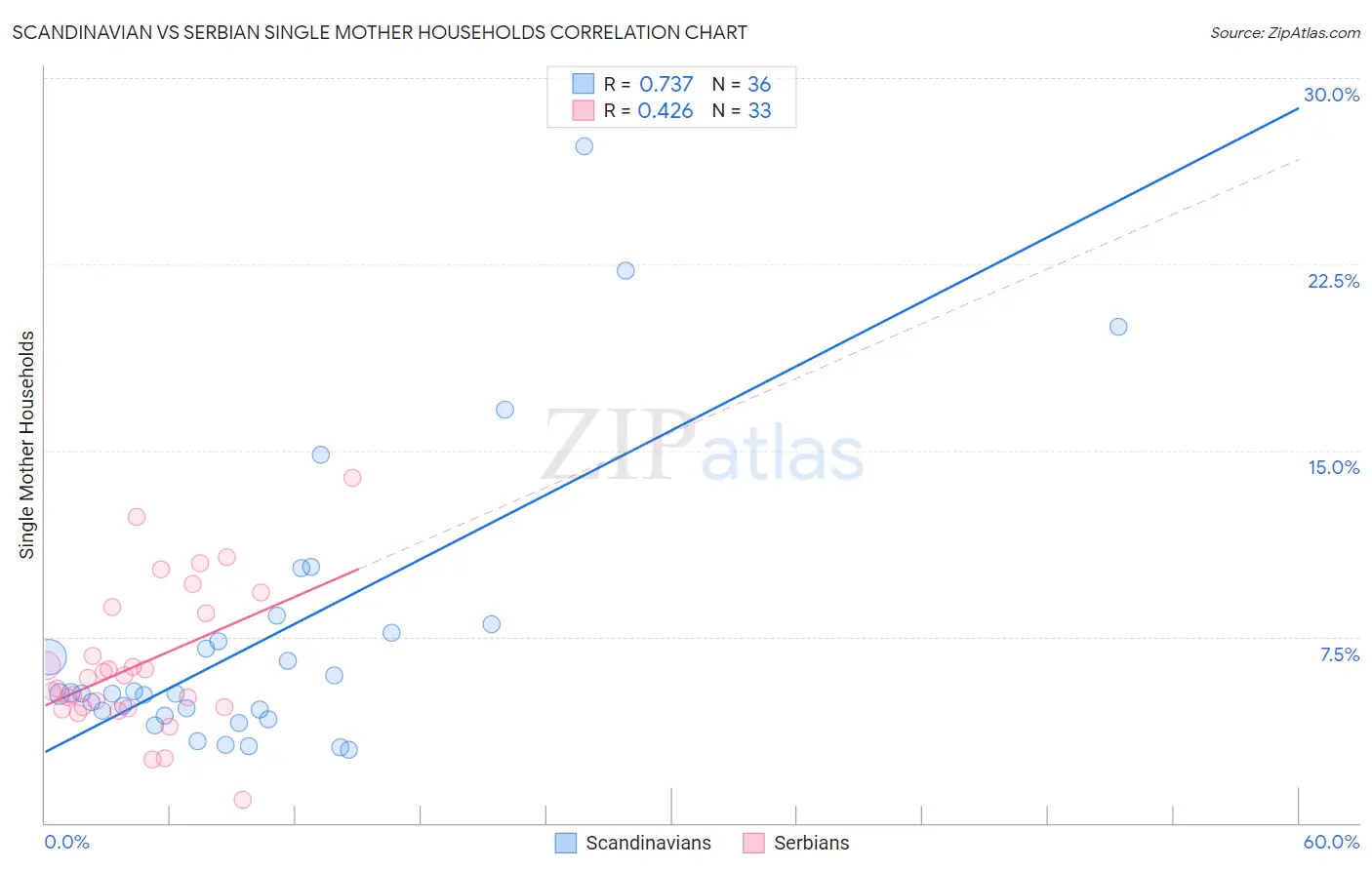Scandinavian vs Serbian Single Mother Households
COMPARE
Scandinavian
Serbian
Single Mother Households
Single Mother Households Comparison
Scandinavians
Serbians
5.8%
SINGLE MOTHER HOUSEHOLDS
96.2/ 100
METRIC RATING
100th/ 347
METRIC RANK
5.7%
SINGLE MOTHER HOUSEHOLDS
96.7/ 100
METRIC RATING
93rd/ 347
METRIC RANK
Scandinavian vs Serbian Single Mother Households Correlation Chart
The statistical analysis conducted on geographies consisting of 470,147,403 people shows a strong positive correlation between the proportion of Scandinavians and percentage of single mother households in the United States with a correlation coefficient (R) of 0.737 and weighted average of 5.8%. Similarly, the statistical analysis conducted on geographies consisting of 266,907,354 people shows a moderate positive correlation between the proportion of Serbians and percentage of single mother households in the United States with a correlation coefficient (R) of 0.426 and weighted average of 5.7%, a difference of 0.42%.

Single Mother Households Correlation Summary
| Measurement | Scandinavian | Serbian |
| Minimum | 2.9% | 0.92% |
| Maximum | 27.3% | 13.9% |
| Range | 24.3% | 13.0% |
| Mean | 7.5% | 6.4% |
| Median | 5.2% | 5.8% |
| Interquartile 25% (IQ1) | 4.4% | 4.6% |
| Interquartile 75% (IQ3) | 7.8% | 8.5% |
| Interquartile Range (IQR) | 3.4% | 3.9% |
| Standard Deviation (Sample) | 5.7% | 2.9% |
| Standard Deviation (Population) | 5.6% | 2.8% |
Demographics Similar to Scandinavians and Serbians by Single Mother Households
In terms of single mother households, the demographic groups most similar to Scandinavians are Immigrants from Poland (5.8%, a difference of 0.010%), German (5.8%, a difference of 0.030%), English (5.8%, a difference of 0.030%), Scottish (5.8%, a difference of 0.050%), and Northern European (5.8%, a difference of 0.060%). Similarly, the demographic groups most similar to Serbians are Immigrants from Western Asia (5.7%, a difference of 0.010%), Basque (5.7%, a difference of 0.050%), Slovak (5.7%, a difference of 0.11%), European (5.7%, a difference of 0.24%), and Austrian (5.7%, a difference of 0.26%).
| Demographics | Rating | Rank | Single Mother Households |
| Finns | 97.6 /100 | #86 | Exceptional 5.7% |
| Immigrants | Turkey | 97.5 /100 | #87 | Exceptional 5.7% |
| Israelis | 97.4 /100 | #88 | Exceptional 5.7% |
| Ukrainians | 97.2 /100 | #89 | Exceptional 5.7% |
| Immigrants | Indonesia | 97.2 /100 | #90 | Exceptional 5.7% |
| Europeans | 97.0 /100 | #91 | Exceptional 5.7% |
| Immigrants | Western Asia | 96.7 /100 | #92 | Exceptional 5.7% |
| Serbians | 96.7 /100 | #93 | Exceptional 5.7% |
| Basques | 96.7 /100 | #94 | Exceptional 5.7% |
| Slovaks | 96.6 /100 | #95 | Exceptional 5.7% |
| Austrians | 96.4 /100 | #96 | Exceptional 5.7% |
| Tlingit-Haida | 96.4 /100 | #97 | Exceptional 5.7% |
| Immigrants | South Africa | 96.3 /100 | #98 | Exceptional 5.7% |
| Immigrants | Poland | 96.3 /100 | #99 | Exceptional 5.8% |
| Scandinavians | 96.2 /100 | #100 | Exceptional 5.8% |
| Germans | 96.2 /100 | #101 | Exceptional 5.8% |
| English | 96.2 /100 | #102 | Exceptional 5.8% |
| Scottish | 96.2 /100 | #103 | Exceptional 5.8% |
| Northern Europeans | 96.2 /100 | #104 | Exceptional 5.8% |
| Taiwanese | 96.1 /100 | #105 | Exceptional 5.8% |
| Immigrants | Ukraine | 95.9 /100 | #106 | Exceptional 5.8% |